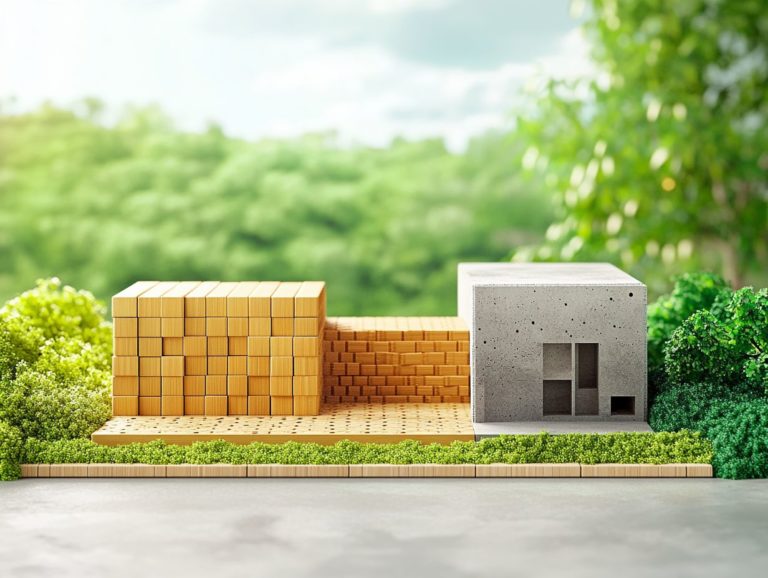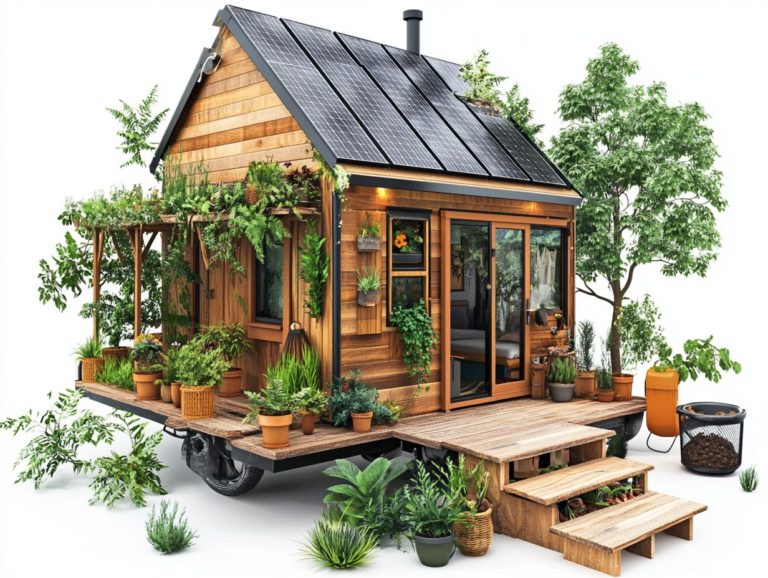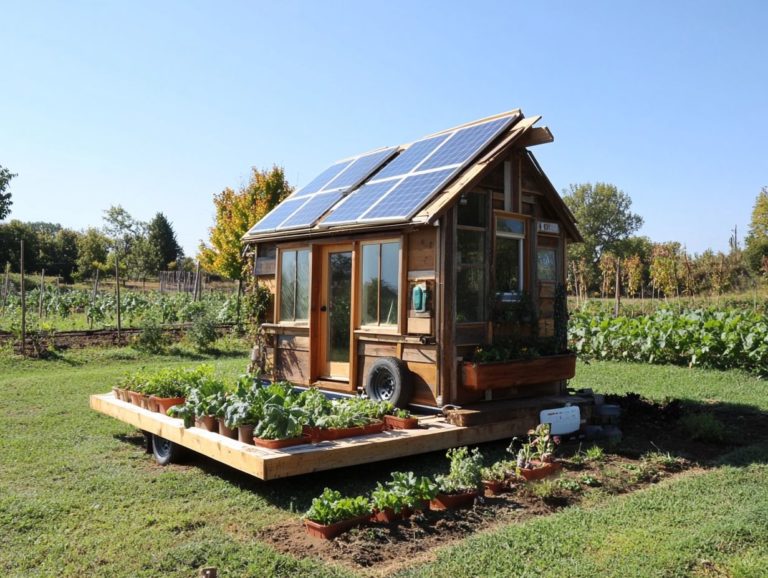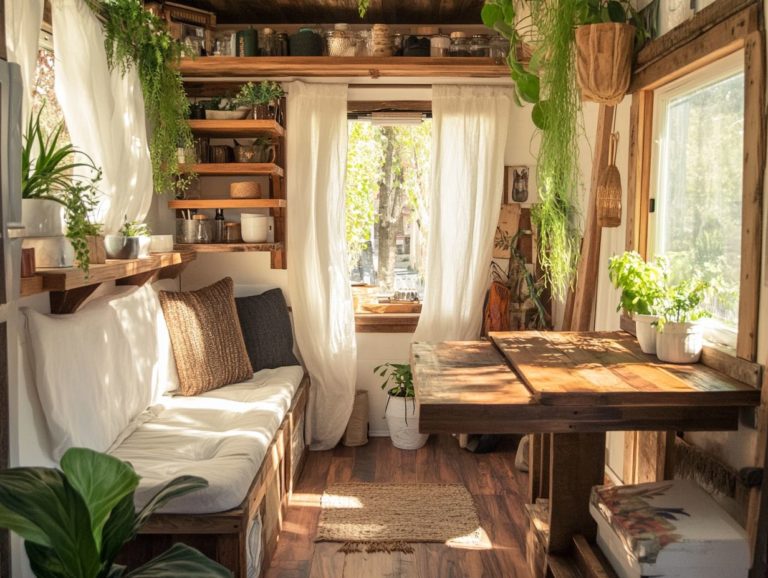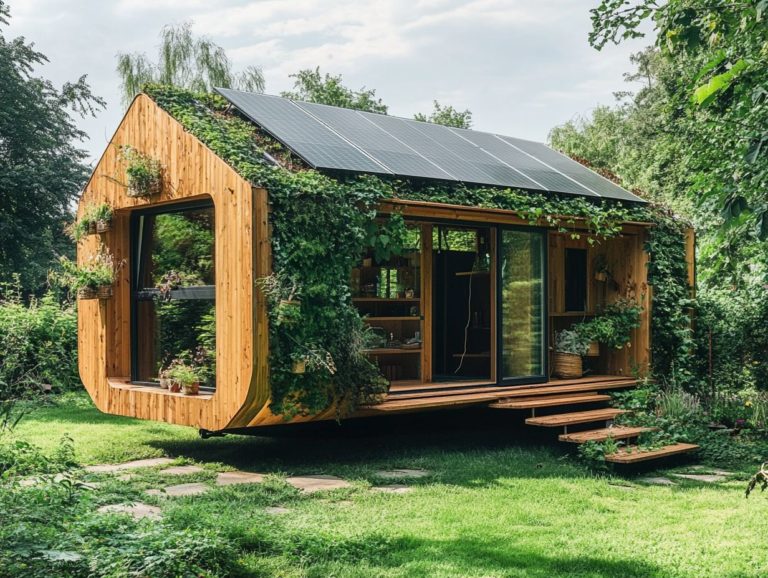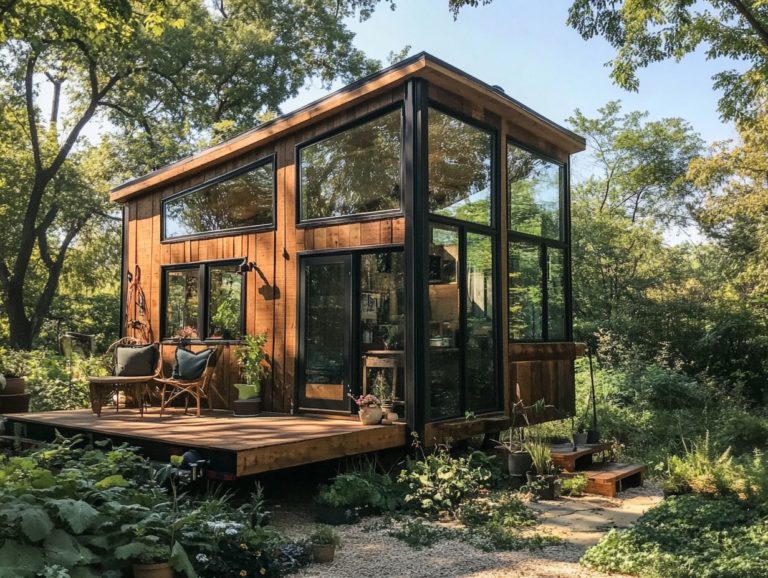5 Tips for Sustainable Tiny House Renovations
Considering a renovation for your tiny house? Embracing sustainability is crucial in crafting a space that is charming and environmentally responsible.
Here are five essential tips to help you establish a strong foundation for your tiny home transformation. Every decision matters, from selecting sustainable materials to maximizing natural light and incorporating energy-efficient features.
Explore how you can create a cozy, eco-conscious haven that reflects your values and lifestyle!
Contents [hide]
- Key Takeaways:
- 1. Start with a Solid Foundation
- 2. Use Sustainable Materials
- 3. Incorporate Energy-Efficient Features
- 4. Utilize Natural Light and Ventilation
- 5. Consider Alternative Energy Sources
- What Is the Concept of Tiny House Living?
- Why Is Sustainability Important in Tiny House Renovations?
- What Are Some Sustainable Materials and How Can They Be Used in Tiny House Renovations?
- How Can Energy-Efficient Features Be Incorporated into Tiny House Renovations?
- What Are the Benefits of Natural Light and Ventilation in Tiny Houses?
- What Are Some Alternative Energy Sources That Can Be Used in Tiny Houses?
- Frequently Asked Questions
- What are some tips for making a tiny house renovation sustainable?
- How can I save energy in my tiny house renovation?
- What are some ways to conserve water in a tiny house renovation?
- How can I incorporate renewable energy into my tiny house renovation?
- What are some budget-friendly sustainable options for a tiny house renovation?
- Tips for Making a Tiny House Renovation More Environmentally Friendly
Key Takeaways:
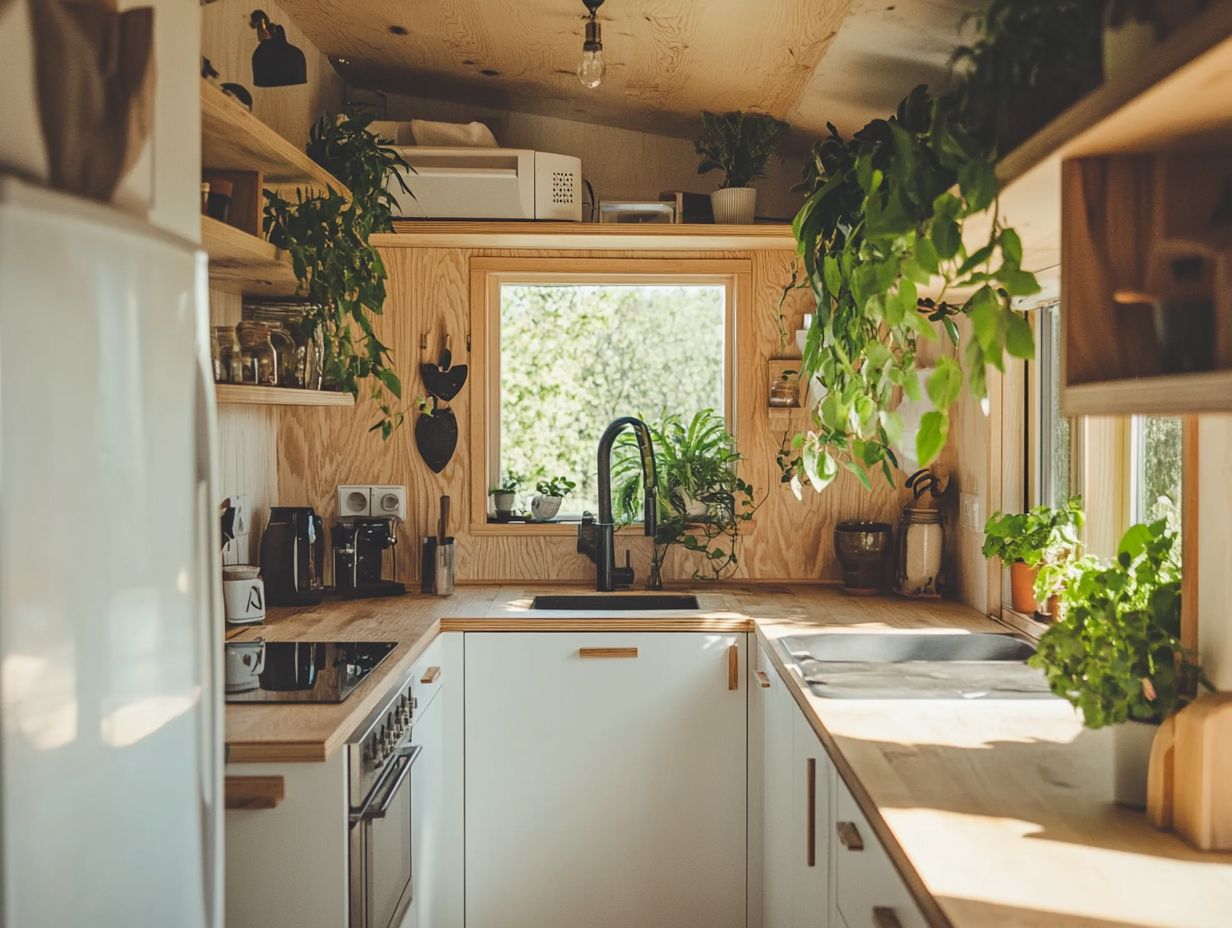
- Start with a solid foundation to ensure the stability and longevity of your renovation.
- Use sustainable materials like reclaimed wood and bamboo to create a unique aesthetic.
- Incorporate energy-efficient features like LED lighting and low-flow fixtures to save on utility costs.
1. Start with a Solid Foundation
Your tiny home starts with a solid foundation it s essential for ensuring structural integrity and longevity. This step supports overall stability and reduces your home’s carbon footprint.
Choose high-quality, sustainable materials that align with local guidelines to boost energy efficiency. Understanding local zoning laws will prevent costly renovations later.
By considering these elements, you will create a balance between sustainability and compliance, paving the way for a thoughtfully designed, eco-friendly tiny home.
2. Use Sustainable Materials
Incorporating sustainable materials like recycled timber and reclaimed wood promotes eco-friendly practices. These choices support local businesses and significantly lower your environmental footprint.
Opt for materials like bamboo and straw bales that provide excellent insulation and are rapidly renewable. Local suppliers offer many sustainable options, promoting community conservation efforts.
3. Incorporate Energy-Efficient Features
Maximize energy efficiency by integrating features such as solar panels, composting toilets, greywater recycling, and rainwater harvesting systems. These systems reduce reliance on conventional utilities and promote sustainable living.
Imagine slashing your electricity bills by harnessing solar energy! Composting toilets transform waste into valuable compost, significantly reducing water usage.
With greywater recycling, you can repurpose water from sinks and showers for irrigation. Rainwater harvesting systems capture rainfall for various uses, easing the demand on municipal supplies.
Select high-efficiency models and consider professional installation for optimal performance. This strategy enhances your savings and decreases energy costs.
4. Utilize Natural Light and Ventilation
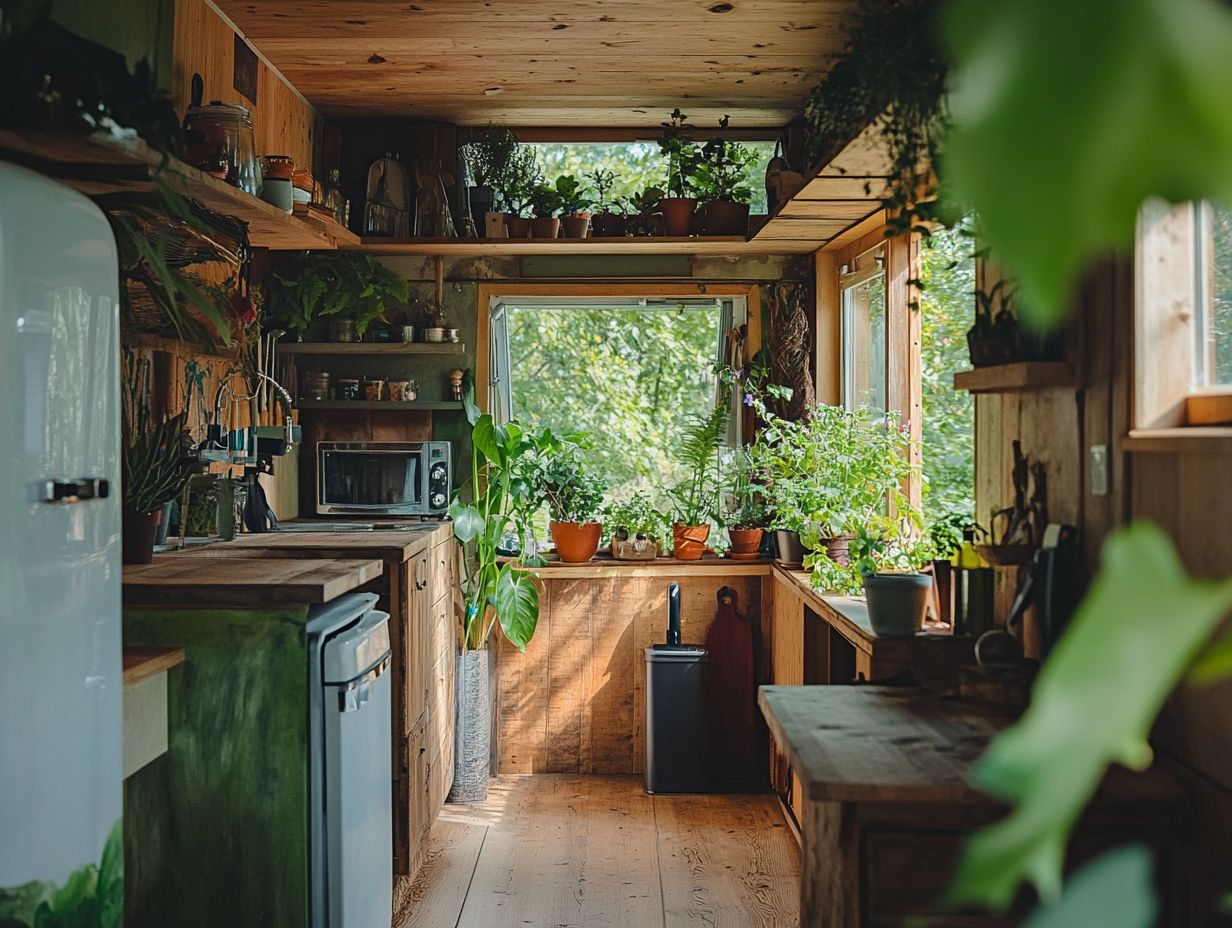
Utilizing natural light and proper ventilation in your tiny home can significantly enhance your living environment. It fosters a healthier indoor atmosphere that reduces stress and elevates your overall well-being.
By integrating thoughtful design elements like strategically placed windows you invite abundant sunlight. This also facilitates efficient airflow throughout your space. For instance, aligning windows directly across from each other promotes cross-ventilation, which is the flow of fresh air through your home, allowing fresh air to circulate freely and cool your home naturally.
This approach not only creates a more pleasant atmosphere but also reduces your reliance on artificial lighting and air conditioning, leading to lower energy consumption.
A well-ventilated environment improves indoor air quality, which is crucial for your health. It minimizes allergens and enhances your comfort.
5. Consider Alternative Energy Sources
Considering alternative energy sources, like solar panels, can enable you as a tiny homeowner to significantly reduce energy consumption. You can enjoy incredible savings that can boost your finances, all while adhering to local regulations.
By exploring options such as wind turbines and geothermal heating, you can create a more sustainable living environment. This ultimately shrinks your carbon footprint. Implementing these energy sources not only boosts your home’s efficiency but also fosters a sense of independence from traditional power grids.
Start by researching local ordinances to grasp the requirements for installing and using these technologies. Connecting with local agencies can provide invaluable insights into necessary permits and potential incentives. This will guide you through the often intricate regulatory landscape with confidence.
What Is the Concept of Tiny House Living?
Tiny house living offers you an alternative lifestyle that champions simplicity, sustainable living, and decluttering. It enables you to focus on what truly matters while maximizing space through multi-functional furniture.
By embracing minimalism, you can prioritize experiences over possessions. This paves the way for a more fulfilling life. Downsizing your living space can significantly reduce your living costs, promoting financial stability in the process.
Choosing a tiny home often goes hand-in-hand with eco-friendly practices. These include utilizing renewable materials and energy-efficient appliances. This not only reduces your carbon footprint but also contributes to the health of the planet.
Those who embark on this journey frequently discover a newfound sense of freedom and flexibility. With fewer material possessions to manage, you ll enjoy less maintenance and a more carefree existence.
Why Is Sustainability Important in Tiny House Renovations?
Sustainability is essential in your tiny house renovations. It helps minimize your environmental impact while promoting the use of quality materials and enhancing energy efficiency throughout your home.
Incorporating sustainable practices during renovation ensures that fewer resources are wasted and fosters a sense of community responsibility. When you choose eco-friendly materials, you contribute to reducing landfill waste and support local suppliers who prioritize ethical sourcing.
Utilizing renewable energy solutions, like solar panels, enables you to lower your utility bills. This encourages a shift toward a greener energy future. By opting for smart renovation techniques, you pave the way for a healthier planet. You transform your tiny home into not just a personal sanctuary but a step towards a more sustainable way of living.
What Are Some Sustainable Materials and How Can They Be Used in Tiny House Renovations?
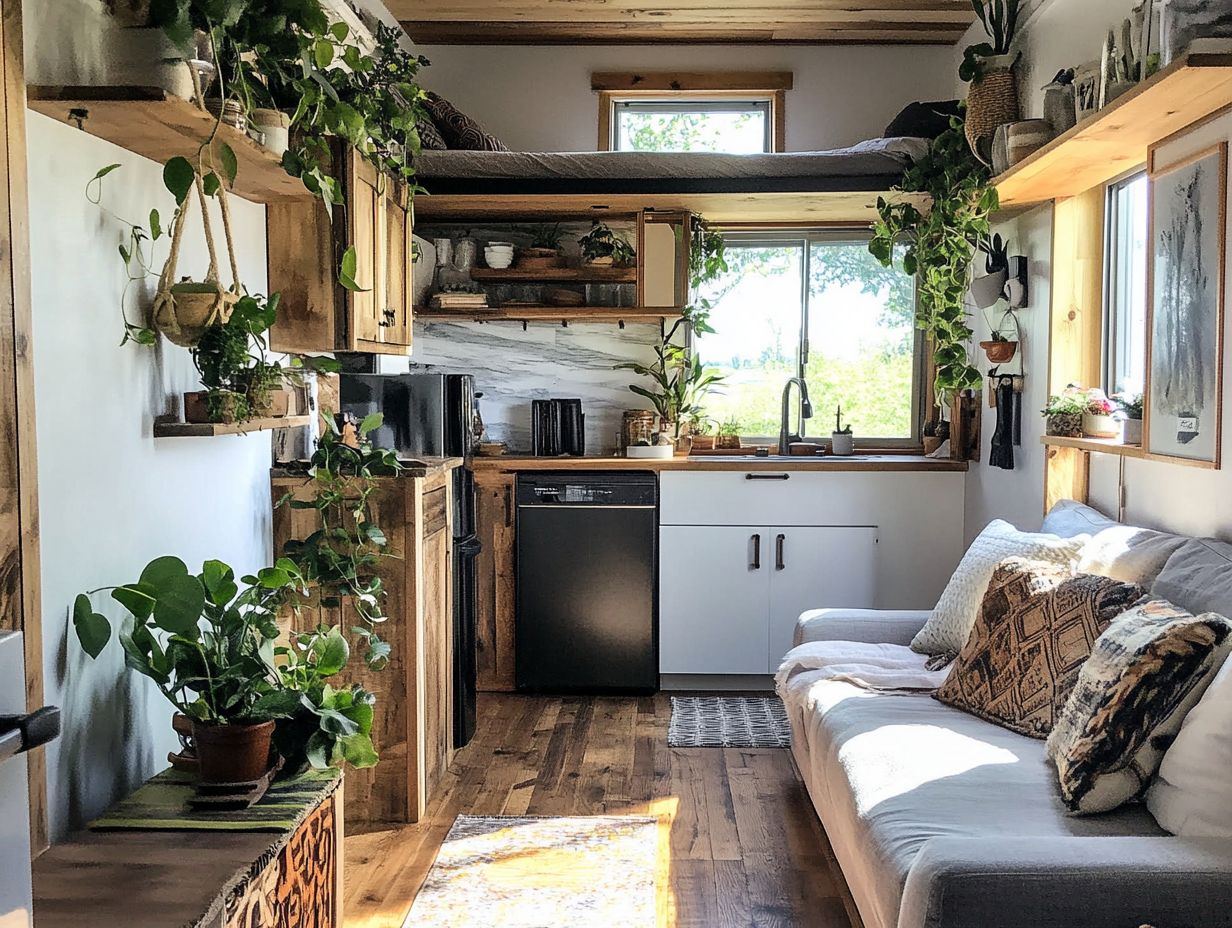
In tiny house renovations, you can incorporate sustainable materials like recycled timber and reclaimed wood. These materials can be used in various applications, from structural elements to aesthetic finishes.
This approach not only achieves durability but also embraces an eco-friendly design. Bamboo is another excellent option, often chosen for flooring and cabinetry due to its rapid growth and less harm to the environment.
Recycled metal can also be utilized as roofing or siding, providing a sleek, modern look while resisting weathering. Each of these materials enhances energy efficiency and adds unique character to your space.
By utilizing such resources, you can significantly reduce waste and carbon footprints. This makes a powerful statement about sustainable living.
How Can Energy-Efficient Features Be Incorporated into Tiny House Renovations?
Incorporating energy-efficient features like solar panels, composting toilets, and greywater recycling systems into your tiny house renovations can significantly enhance sustainability. These upgrades also minimize monthly expenses associated with energy and water use.
Such installations champion eco-friendliness while cultivating a comfortable living space that resonates with a minimalist lifestyle. For instance, choosing high-efficiency appliances and LED lighting can further reduce your power consumption.
When considering these upgrades, it s crucial to assess your space’s specific needs. Evaluating the installation requirements is essential as well.
Conducting thorough research to compare options will help you select the most suitable systems. This ensures you maximize efficiency and achieve long-term savings.
Engaging local experts can provide invaluable insights into tailored solutions that align perfectly with your specific climate and living situation. This allows you to create a detailed plan for your home design.
What Are the Benefits of Natural Light and Ventilation in Tiny Houses?
The advantages of natural light and ventilation in tiny houses are remarkable. They offer improved air quality and a healthier indoor environment that enhances your overall living experience.
Smart design helps lower stress and boosts your well-being. These features create a cozy atmosphere and help you feel more connected to the outdoors.
By incorporating elements like large windows, skylights, and open layouts, you let sunlight flood into your small haven. This makes it feel expansive and airy.
Cross-ventilation, achieved by strategically placing windows and vents, circulates fresh air, minimizing humidity and odors. This contributes to a healthier indoor environment.
Such design choices maximize the use of natural resources and promote a sustainable lifestyle. You can thrive in a compact yet comfortable living situation while embracing smart design principles.
Don t miss out on creating your dream tiny house! Explore these ideas to enhance your living space today.
What Are Some Alternative Energy Sources That Can Be Used in Tiny Houses?
Alternative energy sources, especially solar panels, can change your life! They significantly reduce energy consumption and lead to impressive financial savings over time, which can help lower your energy bills.
Consider wind turbines and small water-powered generators as excellent options to boost energy efficiency in your compact living space. These systems harness natural resources to generate electricity, making them adaptable to various geographic locations and climates. If you re lucky enough to live in an area with consistent wind gusts, wind turbines could be your best friend. Meanwhile, small water-powered generators work wonders near flowing water sources, thus contributing to a more sustainable living approach.
While installing these alternative energy sources may require navigating local regulations and permits, the initial investment can pay off handsomely with long-term savings on utility bills. You will enjoy reduced energy costs and gain a sense of independence from traditional power grids, creating a sustainable home environment.
Frequently Asked Questions
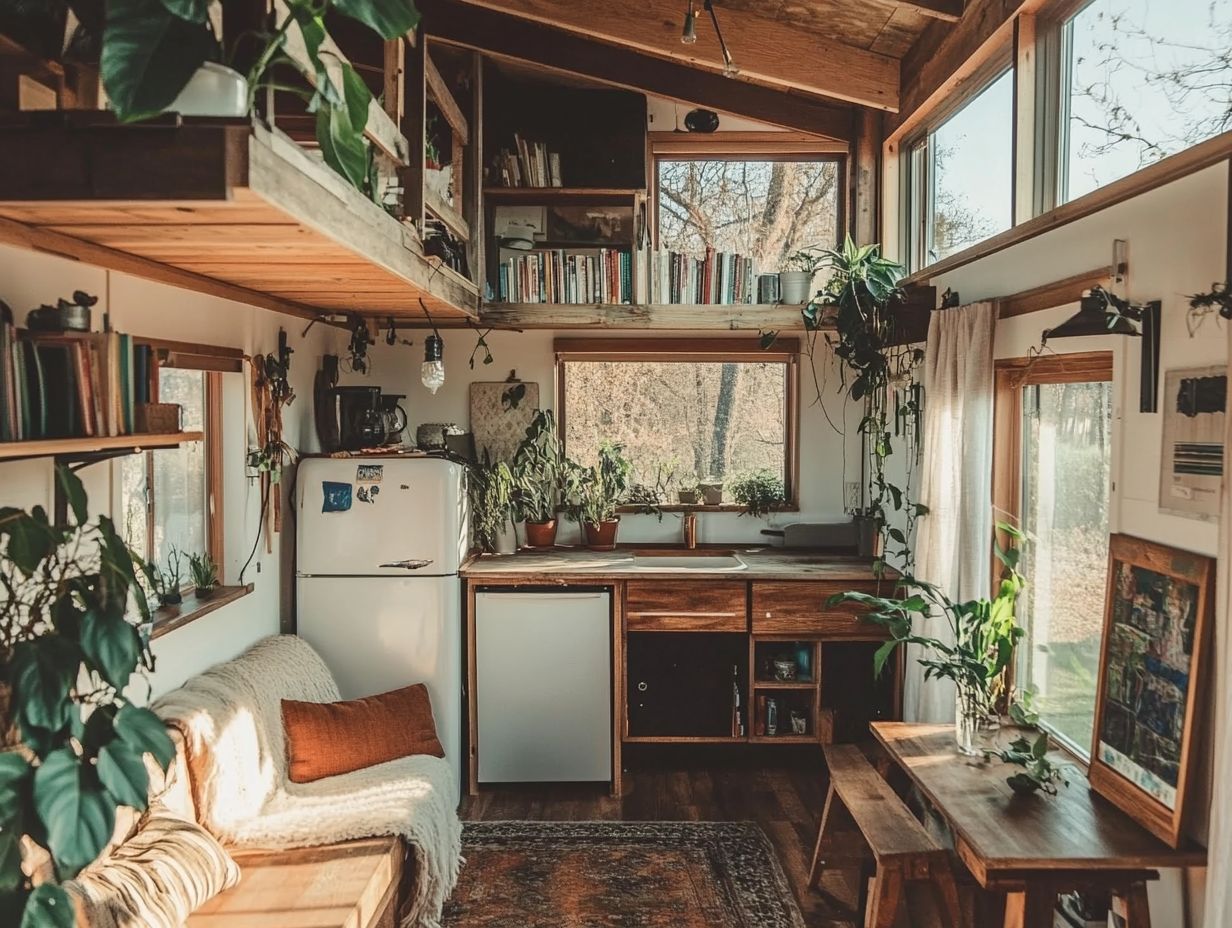
What are some tips for making a tiny house renovation sustainable?
1. Use eco-friendly building materials such as reclaimed wood and recycled insulation to minimize your environmental impact. Incorporate reusable materials whenever possible.
How can I save energy in my tiny house renovation?
2. Install energy-efficient appliances and use natural lighting as much as possible to reduce electricity usage and save on utility bills. You can also look for ways of reducing clutter to create a more open space.
What are some ways to conserve water in a tiny house renovation?
3. Install a low-flow showerhead and toilet, collect rainwater for gardening, and use a greywater system (a system that recycles water from sinks and showers for other uses) to reuse water for flushing toilets or watering plants. Consider incorporating herbs and vegetables into your garden as well.
How can I incorporate renewable energy into my tiny house renovation?
4. Consider installing solar panels or a wind turbine to generate your own clean energy and reduce your reliance on traditional power sources. Explore local options for community support and local businesses that can aid in your transition.
What are some budget-friendly sustainable options for a tiny house renovation?
5. Use recycled timber or salvaged materials, shop at thrift stores for furniture and decor, and consider DIY projects to save money while still being eco-friendly. Check out flea markets and Facebook Marketplace for great deals.
Tips for Making a Tiny House Renovation More Environmentally Friendly
Ready to make your tiny house renovations eco-friendly? Here are some exciting tips!
Use non-toxic, VOC-free paints and sealants. Incorporate natural elements like indoor plants and wood. Proper insulation will help reduce energy usage and waste.
This approach minimizes your carbon footprint and creates a calm home environment.

